
Vergennes is a city located in the northwest quadrant of Addison County, Vermont, United States. The municipality is bordered by the towns of Ferrisburgh, Panton, and Waltham. As of the 2020 census, its population was 2,553. It is the smallest of Vermont's 10 cities in terms of population, though the city of Winooski has the smallest area. It was the first city chartered in the state of Vermont and is the only city in Addison County.
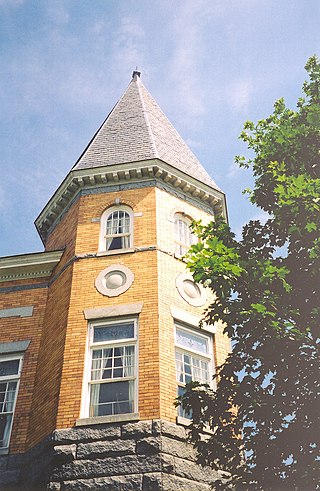
Derby Line is an incorporated village in the town of Derby in Orleans County, Vermont, United States, slightly north of the 45th parallel, the nominal U.S.-Canada boundary. The population was 687 at the 2020 census.

Stanstead is a town in the Memphrémagog Regional County Municipality in the Estrie region of Quebec, located on the Canada–United States border across from Derby Line, Vermont.

The Haskell Free Library and Opera House is a Victorian building that straddles the Canada–United States border, in Rock Island, Quebec, and Derby Line, Vermont, respectively. The Opera House opened on June 7, 1904, having deliberately been built on the international border. It was declared a heritage building by both countries in the 1970s and 1980s.
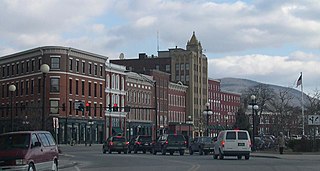
Rutland is the only city in and the seat of Rutland County, Vermont, United States. As of the 2020 census, the city had a total population of 15,807. It is located approximately 65 miles (105 km) north of the Massachusetts state line, 35 miles (56 km) west of New Hampshire state line, and 20 miles (32 km) east of the New York state line. Rutland is the third largest city in the state of Vermont after Burlington and South Burlington. Rutland City is completely surrounded by Rutland Town, which is a separate municipality. The downtown area of the city is listed as a historic district on the National Register of Historic Places.

A Carnegie library is a library built with money donated by Scottish-American businessman and philanthropist Andrew Carnegie. A total of 2,509 Carnegie libraries were built between 1883 and 1929, including some belonging to public and university library systems. 1,689 were built in the United States, 660 in the United Kingdom and Ireland, 125 in Canada, and 25 others in Australia, South Africa, New Zealand, Serbia, Belgium, France, the Caribbean, Mauritius, Malaysia, and Fiji.

The Chicago Public Library (CPL) is the public library system that serves the City of Chicago in the U.S. state of Illinois. It consists of 81 locations, including a central library, three regional libraries, and branches distributed throughout the city's 77 Community Areas. CPL was founded in 1872, in the wake of the Great Chicago Fire.

Beebe Plain is an unincorporated community in the town of Derby in Orleans County, Vermont, United States, which extends into the municipality of Stanstead, Quebec, Canada. The village is divided by the Canada–United States border between Canada and the United States; the Canadian portion of Beebe Plain had the status of an incorporated municipality in its own right until 1995.
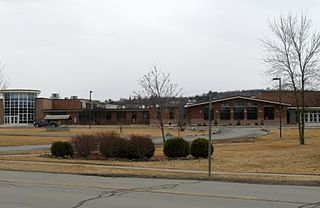
Vergennes Union High School is a high school/junior high school of about 700 students in Vergennes, Vermont, United States. The school serves the city of Vergennes, as well as the towns of Addison, Ferrisburgh, Panton, and Waltham. This group of towns is the Addison Northwest School District.
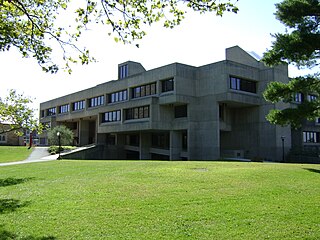
The Richard G. Folsom Library is a research library in the Rensselaer Libraries system constructed in the Brutalist style located on the campus of Rensselaer Polytechnic Institute in Troy, NY. It is named after Richard Gilman Folsom, the President of the Institute from 1958–1971. The Folsom Library offers a variety of services to students and patrons of the library. In addition to loans, these services include class reserves, general writing and presentation assistance through the Center for Communication Practices, cultural and educational events, inter-library loans through ConnectNY, individual and group room reservations, computer labs, and wireless internet.
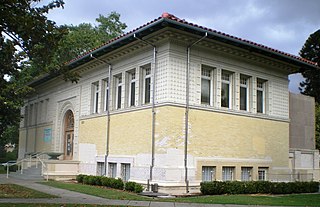
Vermont Square Branch Library is the oldest branch library in the Los Angeles Public Library system. Located about a mile southwest of the University of Southern California campus, in the Vermont Square district, it was built in 1913 with a grant from Andrew Carnegie. One of three surviving Carnegie libraries in Los Angeles, it has been designated a Historic-Cultural Monument and listed on the National Register of Historic Places.

The Nashua Public Library (NPL) is the public library of Nashua, New Hampshire.

Addison is a town in Addison County, Vermont, United States. It was founded October 14, 1761. The population was 1,365 at the 2020 census.
Waterfield Library is the primary library of Murray State University, Kentucky, United States. It is named for Harry Lee Waterfield, and is a library for students as well as the local community. Originally the student center at Murray State it became the library years later.
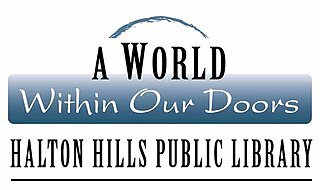
Halton Hills Public Library (HHPL) is the public library system for the Town of Halton Hills, Ontario, Canada. Through its two branches and its website, www.hhpl.on.ca, the Halton Hills Public Library provides a range of services for Halton Hills residents. There are approximately 17,000 active cardholders, most residing in the communities of Georgetown, Acton, Limehouse, Glen Williams, Speyside, Norval, and surrounding areas.
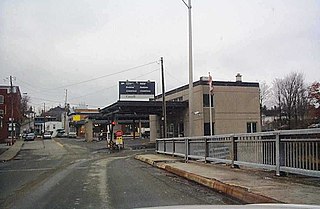
The Derby Line–Stanstead Border Crossing is a border crossing station on the Canada–United States border, connecting the towns of Stanstead, Quebec and Derby Line, Vermont. It connects Main Street in Derby Line with Quebec Route 143 in Stanstead. It is one of two local crossings between the two towns, which historically had many more. This was a major crossing point until the construction of Interstate 91 (I-91) and the Derby Line–Rock Island Border Crossing in 1965. The historic 1930s United States station facilities were listed on the National Register of Historic Places in 2014. Both stations are open 24 hours per day.
The Hernando County Public LibrarySystem has 4 branches located in Hernando County, Florida on the west central coast of the state and serves approximately 192,186 residents. The main branch is located in downtown Brooksville and was dedicated as the Frederick Eugene Lykes Jr. Memorial Library in 1950. There are additional branches in East Brooksville, West Brooksville, and Spring Hill. The Florida Library Association chose the Hernando system as its 2013 Library of the Year. While Hernando County established one of the first bookmobiles in the state, it is no longer operational. As of 2020, the staff totaled 32 people, including 7 librarians and 25 other staff members. The library had about 92,940 cardholders and had 454,112 circulation transactions in 2020. The library is a member of the Tampa Bay Library Consortium.
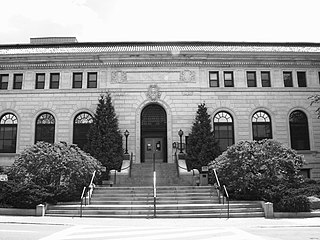
The Manchester City Library was established in the mid-1850s, and serves the population of Manchester, the largest city in the state of New Hampshire. It is one of twelve libraries in the GMILCS consortium that provides materials and services to the greater Manchester area, and is on the U.S. Department of Interior's National Register of Historic Places, listed under the Victory Park Historic District as a contributing property, one of the four buildings that face the park. Even though the current building was completed in 1914, library services were provided as early as 1844 through a membership-based organization known as the Manchester Atheneum, and then as a public library which was housed in two other buildings. Over the last century, the library has undergone many renovations to maintain the historical integrity of the building. It has continuously provided materials in various formats, as well as vital services to the public, including internet access, literacy programs, community events, and educational workshops and classes.

The Lake County Public Library System (LCLS) is a library system located in Lake County, Florida.

Stephen Bates was an American law enforcement officer who served as sheriff and police chief of the city of Vergennes, Vermont, for 25 years between 1879 and 1907. He was the first Black chief law enforcement officer in Vermont and the only one for 140 years, until 2020. Additionally, Bates was almost certainly the first Black sheriff elected outside the Reconstruction-era South.




















